Digital Training and Advanced Learning in Occupational Safety and Health Based on Modern and Affordable Technologies
Abstract
:1. Introduction
2. Materials and Methods
2.1. Current Practices and Requirements in Training and Learning of OSH
2.2. The Proposed Features and Software Architecture
- Intuitive working environment, ensuring fluent reporting, tracking and analysis of learning progress.
- Easy accessibility, so that students could use the system at university premises, laboratories or during their internship at companies [51].
- Precise and real-time measurements by using Android devices with built-in sensors (Most Android platforms provide an option to access built-in sensors by using the corresponding Android sensor framework, which is the part of android.hardware package and it includes necessary classes and interfaces. Additionally, a number of useful components, i.e., for reading bar codes or access to different Wi-Fi based devices and sensors, could be found as open-source packages (i.e., on portals like the GitHub) which could be used for measuring motion, orientation, and various environmental parameters (temperature and humidity).
- Wi-Fi access for reading inputs from attached or sensors available on the local network and remote devices.
2.3. Workflow and Functionalities of the React Native Application
- Localization of unsafe conditions and unsafe acts through the intuitive graphical user interface (GUI). A precise location (Model zone) of UA and/or UC could be detected:
- ○
- Manually by selecting an area from the drop-down menu with predefined sectors, or
- ○
- Automatically by using the built-in sensors for a precise definition of the location.
- Identification of different types of UA and UC. Students could select specific fields from the drop-down menu with predefined categories of unsafe conditions and unsafe acts. The list of UA/UC for a specific company or training example could differ according to industrial standards and specific characteristics of the working environment. However, in both cases, one has to provide information about spotted risks through the interaction with the GUI component.
- ○
- In this step, potential hazards and risks could be connected to the specific component identified by the QR bar code. The software has the option for reading bar codes depicted in Figure 2. The QR code enables linking physical objects in the real world with digital content and assets online (in this case 3-D models, standards, directives, slideshows). This is an approach in which professors can attach all sorts of additional information to the equipment to assists in the use and improvement of workplace safety.
- ○
- The second component is using the built-in sensors for changes in the ambient environment near a device/component, temperature sensor and humidity, positioning sensor as well as open options to get data from other Wi-Fi sensors.
- Risk assessment (risk level) of the spotted UA/UC. This represents an initial-subjective assessment performed by a student on the site, while the final grading and evaluation of the task will be performed later by a professor. If a professor notices that his/her student misunderstood the safety issue, he/she could provide for them additional training or instructions.
- Description, which enables students to provide an opinion about UC/AC in the form of text or voice message. Students determine the best way to mitigate the risks of each of the hazards.
- Task definition. A task could be defined as a real-life problem, a pre-defined showcase (with assigned risks and hazards), or an educational task that needs to be done within an appropriate model zone in the company. In the first case, we assume that students work in the real-life environment and can use location sensors as well as the other ones as a part of the application, while in the second case, students receive and upload the problem that they need to identify, describe and report.
- Collection, correction, grading and storage of tasks delegated to students. Professors could form the list of the tasks that will be assigned to the students in order to be able to correct and grade the same.
- Reporting about resolved tasks or asking for additional instructions the students and professors could have consultations. Professors do not have to wait until the end of tasks’ completion, but they could provide additional information in real time.
3. Results and Discussion
3.1. Description of Educational Task and Its Purpose in Learning OSH
- The first step: Identification of potential UA/UC. Students need to make the correct identification of potential UA/UC and to forward the information to the system. The application evaluates students’ input and approves or disapproves selected categories of pre-existed UA/UC. One of the key parameters of the success of UA/UC identification is the acceptance rate of successfully identified UA/UC out of a total number of requests. In this step, students could record the exact position of the object (for example) or location using a positioning sensor from SafeST.
- The second step: Assess the risk and provide a risk level rating to each hazard. According to the defined task in the model zone, students access the level of the risk and define priority level. In this step, students evaluate possible consequences regarding the likelihood of its occurrence and assess the risk level of identified UA/UC. In addition, students could use the system for positioning, and sensors for measurement of vibration, temperature as well as some other parameters (using the options from a SafeST). Students also have the option to have direct communication with professor or to use theoretical material and other information provided by QR code.
- The third step: Reduce risks. After successful identification of UA/UC and risk assessment, and gathered data from sensors if applicable, students prepare a report suggesting the list of preventive measures for implementation in order to reduce risks. The prepared report will be sent to the professor for evaluation and to the database for storage for future use.
- The fourth step: Learning from examples. The system contains previously made reports so students could browse the system by risk or by UA/UC category in order to find documented reports with preventive measures. In addition, the system keeps all previous versions so students could save their reports and make additional versions or corrections later on.
- The fifth step: Verify effectiveness. If the level of the residual risk is acceptable, then the risk assessment process is complete.
3.2. Description of Educational Task and Its Purpose in Learning OSH
- First of all, one of the limitations is the number of sensors used in this solution. In this solution, we employed a limited number of built-in Android sensors. Moreover, the other built-in sensors could be used as well as Wi-Fi sensors (or even combining sensors and systems such as Arduino, Raspberry Pi).
- The system could be extended with the use of wearable sensors. One of the possible improvements is to provide wearable sensors (on the worker or students) that will gather data and the same to the mobile application.
- The application could be improved in order to “recognize” specific situations and risks providing the possible solutions or providing the option that the system learns using solved examples and recognize possible patterns.
- System could be modified and adapted to the specific industrial sector (construction industry) or used for specific business and industrial purposes.
- In educational and training field application, there is a limited number of defined templates. A number of templates could be increased as well as the system could be interconnected with other learning platforms (using QR code reader the user could be forwarded to different online resources or lessons in the LMS system).
4. Conclusions
Author Contributions
Funding
Acknowledgments
Conflicts of Interest
References
- Schwatka, N.V.; Rosecrance, J.C. Safety climate and safety behaviors in the construction industry: The importance of co-workers commitment to safety. Work 2016, 54, 401–413. [Google Scholar] [CrossRef] [PubMed]
- Nordlöf, H.; Wiitavaara, B.; Winblad, U.; Wijk, K.; Westerling, R. Safety culture and reasons for risk-taking at a large steel-manufacturing company: Investigating the worker perspective. Saf. Sci. 2015, 73, 126–135. [Google Scholar] [CrossRef] [Green Version]
- Liu, X.; Huang, G.; Huang, H.; Wang, S.; Xiao, Y.; Chen, W. Safety climate, safety behavior, and worker injuries in the Chinese manufacturing industry. Saf. Sci. 2015, 78, 173–178. [Google Scholar] [CrossRef]
- Hudson, P.T. Safety culture and human error in the aviation industry: In search of perfection. In Aviation Resource Management: Proceedings of the Fourth Australian Aviation Psychology Symposium; Hayward, B.J., Lowe, A.R., Eds.; Routledge: Oxfordshire, UK, 2000; Volume 1, pp. 19–31. [Google Scholar]
- Comberti, L.; Baldissone, G.; Bosca, S.; Demichela, M.; Murè, S.; Petruni, A.; Djapan, M.; Cencetti, S. Comparison of two methodologies for occupational accidents pre-cursors data collection. In Proceedings of the European Safety and Reliability Conference ESREL 2015, Zurich, Switzerland, 7–10 September 2015; pp. 3237–3244. [Google Scholar]
- Demirkesen, S.; Arditi, D. Construction safety personnel’s perceptions of safety training practices. Int. J. Proj. Manag. 2015, 33, 1160–1169. [Google Scholar] [CrossRef]
- Lucchini, R.G.; McDiarmid, M.; van der Laan, G.; Rosen, M.; Placidi, D.; Radon, K.; Kurtz, L.; Landrigan, P. Education and Training: Key Factors in Global Occupational and Environmental Health. Ann. Glob. Health 2018, 84, 436–441. [Google Scholar] [CrossRef] [Green Version]
- Burke, M.J.; Sarpy, S.A.; Smith-Crowe, K.; Chan-Serafin, S.; Salvador, R.O.; Islam, G. Relative effectiveness of worker safety and health training methods. Am. J. Public Health 2006, 96, 315–324. [Google Scholar] [CrossRef] [PubMed]
- Hejduk, I.; Karwowski, W.A. Knowledge Management Framework of the Information Technology-Based Approach for Improving Occupational Safety Training of Young Workers. China Bus. Rev. 2016, 15, 42–47. [Google Scholar]
- Xu, L.D.; Xu, E.L.; Li, L. Industry 4.0: State of the art and future trends. Int. J. Prod. Res. 2018, 56, 2941–2962. [Google Scholar] [CrossRef] [Green Version]
- Lu, Y. Industry 4.0: A survey on technologies, applications and open research issues. J. Ind. Inf. Integr. 2017, 6, 1–10. [Google Scholar] [CrossRef]
- Lee, J.; Bagheri, B.; Kao, H.A. A cyber-physical systems architecture for industry 4.0-based manufacturing systems. Manuf. Lett. 2015, 3, 18–23. [Google Scholar] [CrossRef]
- Wang, X.V.; Kemény, Z.; Váncza, J.; Wang, L. Human–robot collaborative assembly in cyber-physical production: Classification framework and implementation. CIRP Ann. Manuf. Technol. 2017, 66, 5–8. [Google Scholar] [CrossRef] [Green Version]
- Nikolakis, N.; Maratos, V.; Makris, S. A cyber physical system (CPS) approach for safe human-robot collaboration in a shared workplace. Robot. Comput. Integr. Manuf. 2019, 56, 233–243. [Google Scholar] [CrossRef]
- Riaz, Z.; Edwards, D.J.; Thorpe, A. SightSafety: A hybrid information and communication technology system for reducing vehicle/pedestrian collisions. Autom. Constr. 2006, 15, 719–728. [Google Scholar] [CrossRef]
- Sole, M.; Musu, C.; Boi, F.; Giusto, D.; Popescu, V. RFID sensor network for workplace safety management. In Proceedings of the IEEE 18th Conference on Emerging Technologies & Factory Automation (ETFA), Cagliari, Italy, 10–13 September 2013; pp. 1–4. [Google Scholar]
- Lin, P.; Li, Q.; Fan, Q.; Gao, X.; Hu, S. A real-time location-based services system using WiFi fingerprinting algorithm for safety risk assessment of workers in tunnels. Math. Probl. Eng. 2014, 2014, 371456. [Google Scholar] [CrossRef]
- Teimourikia, M.; Fugini, M. Ontology development for run-time safety management methodology in Smart Work Environments using ambient knowledge. Future Gener. Comput. Syst. 2017, 68, 428–441. [Google Scholar] [CrossRef]
- Duffy, V.G.; Wu, F.F.; Ng, P.P. Development of an Internet virtual layout system for improving workplace safety. Comput. Ind. 2003, 50, 207–230. [Google Scholar] [CrossRef]
- Coccorese, D.; D’Angelo, R.; Di Gironimo, G.; Grasso, C.; Minopoli, V.; Papa, S. Interactive Tools for Safety 4.0: Virtual Ergonomics and Serious Games in Tower Automotive. In Proceedings of the 20th Congress of the International Ergonomics Association (IEA 2018), August 2018, Volume V: Human Simulation and Virtual Environments, Work with Computing Systems (WWCS), Process Control, Florence, Italy, 26–30 August 2018; Springer: Cham, Switzerland, 2019; Volume 822, p. 270. [Google Scholar]
- Sun, E.; Zhang, X.; Li, Z. The internet of things (IOT) and cloud computing (CC) based tailings dam monitoring and pre-alarm system in mines. Saf. Sci. 2012, 50, 811–815. [Google Scholar] [CrossRef]
- Zou, P.X.; Lun, P.; Cipolla, D.; Mohamed, S. Cloud-based safety information and communication system in infrastructure construction. Saf. Sci. 2017, 98, 50–69. [Google Scholar] [CrossRef]
- Rashidy, R.A.H.E.; Hughes, P.; Figueres-Esteban, M.; Harrison, C.; Van Gulijk, C. A big data modeling approach with graph databases for SPAD risk. Saf. Sci. 2018, 110, 75–79. [Google Scholar] [CrossRef]
- Sacks, R.; Perlman, A.; Barak, R. Construction safety training using immersive virtual reality. Constr. Manag. Econ. 2013, 31, 1005–1017. [Google Scholar] [CrossRef]
- Nasios, K. Improving Chemical Plant Safety Training Using Virtual Reality. Ph.D. Thesis, University of Nottingham, Nottingham, UK, January 2002. [Google Scholar]
- Buttussi, F.; Chittaro, L. Effects of different types of virtual reality display on presence and learning in a safety training scenario. IEEE Trans. Vis. Comput. Graph. 2018, 24, 1063–1076. [Google Scholar] [CrossRef]
- Shamsudin, N.M.; Mahmood, N.H.N.; Rahim, A.R.A.; Mohamad, S.F.; Masrom, M. Utilization of Virtual Reality Technology Smartphone Application for the Enhancement of Construction Safety and Health Hazard Recognition Training in Piling Work: Pilot Study. Adv. Sci. Lett. 2018, 24, 8660–8662. [Google Scholar] [CrossRef]
- Pedram, S.; Perez, P.; Palmisano, S.; Farrelly, M. A Qualitative Evaluation of the Role of Virtual Reality as a Safety Training Tool for the Mining Industry. In Intersections in Simulation and Gaming; Springer: Cham, Switzerland, 2016; pp. 188–200. [Google Scholar]
- Chittaro, L.; Corbett, C.L.; McLean, G.A.; Zangrando, N. Safety knowledge transfer through mobile virtual reality: A study of aviation life preserver donning. Saf. Sci. 2018, 102, 159–168. [Google Scholar] [CrossRef]
- Tatic, D.; Tesic, B. The application of augmented reality technologies for the improvement of occupational safety in an industrial environment. Comput. Ind. 2017, 85, 1–10. [Google Scholar] [CrossRef]
- Pereira, R.E.; Moore, H.F.; Gheisari, M.; Esmaeili, B. Development and usability testing of a panoramic augmented reality environment for fall hazard safety training. In Advances in Informatics and Computing in Civil and Construction Engineering; Springer: Cham, Switzerland, 2019; pp. 271–279. [Google Scholar]
- Alam, M.F.; Katsikas, S.; Beltramello, O.; Hadjiefthymiades, S. Augmented and virtual reality based monitoring and safety system: A prototype IoT platform. J. Netw. Comput. Appl. 2017, 89, 109–119. [Google Scholar] [CrossRef]
- Kanan, R.; Elhassan, O.; Bensalem, R. An IoT-based autonomous system for workers’ safety in construction sites with real-time alarming, monitoring, and positioning strategies. Autom. Constr. 2018, 88, 73–86. [Google Scholar] [CrossRef]
- Teizer, J. Wearable, wireless identification sensing platform: Self-monitoring alert and reporting technology for hazard avoidance and training (SmartHat). J. Inf. Technol. Constr. 2015, 20, 295–312. [Google Scholar]
- Schall, M.C., Jr.; Sesek, R.F.; Cavuoto, L.A. Barriers to the Adoption of Wearable Sensors in the Workplace: A Survey of Occupational Safety and Health Professionals. Hum. Factors 2018, 60, 351–362. [Google Scholar] [CrossRef] [PubMed]
- Nazir, S.; Manca, D. How a plant simulator can improve industrial safety. Process Saf. Prog. 2015, 34, 237–243. [Google Scholar] [CrossRef]
- Gu, N. Implementing a Mobile App as a Personal Learning Environment for Workplace Learners. In Mobile Learning Design; Springer: Singapore, 2016; pp. 285–300. [Google Scholar]
- Catton, J.; Shaikhi, R.; Fowler, M.; Fraser, R. Designing and Developing an Effective Safety Program for a Student Project Team. Safety 2018, 4, 21. [Google Scholar] [CrossRef] [Green Version]
- Agnusdei, G.P.; Elia, V.; Gnoni, M.G. Is Digital Twin Technology Supporting Safety Management? A Bibliometric and Systematic Review. Appl. Sci. 2021, 11, 2767. [Google Scholar] [CrossRef]
- Agnusdei, G.P.; Elia, V.; Gnoni, M.G. A classification proposal of digital twin applications in the safety domain. Comput. Ind. Eng. 2021, 154, 107137. [Google Scholar] [CrossRef]
- Badri, A.; Boudreau-Trudel, B.; Souissi, A.S. Occupational health and safety in the industry 4.0 era: A cause for major concern? Saf. Sci. 2018, 109, 403–411. [Google Scholar] [CrossRef]
- Gisbert, J.R.; Palau, C.; Uriarte, M.; Prieto, G.; Palazón, J.A.; Esteve, M.; López, O.; Correas, J.; Lucas-Estañ, M.C.; Giménez, P.; et al. Integrated system for control and monitoring industrial wireless networks for labor risk prevention. J. Netw. Comput. Appl. 2014, 39, 233–252. [Google Scholar] [CrossRef]
- Vukicevic, A.M.; Djapan, M.; Stefanovic, M.; Macuzic, I. SafE-Tag mobile: A novel javascript framework for real-time management of unsafe conditions and unsafe acts in SMEs. Saf. Sci. 2019, 120, 507–516. [Google Scholar] [CrossRef]
- Bragatto, P.; Ansaldi, S.; Agnello, P. Small enterprises and major hazards: How to develop an appropriate safety management system. J. Loss Prev. Proc. Ind. 2015, 33, 232–244. [Google Scholar] [CrossRef]
- Gheorghiţa, N. Workaholism: A New Challenge for Organisation Management. Procedia-Soc. Behav. Sci. 2014, 109, 295–300. [Google Scholar] [CrossRef] [Green Version]
- Jackson, S.S.; Fung, M.C.; Moore, M.A.C.; Jackson, C.J. Personality and Workaholism. Pers. Individ. Differ. 2016, 95, 114–120. [Google Scholar] [CrossRef]
- Porter, G. Profiles of workaholism among high-tech managers. Career Dev. Int. 2006, 11, 440–462. [Google Scholar] [CrossRef]
- Al-Fahad, F.N. Students’ attitudes and perceptions towards the effectiveness of mobile learning in King Saud University, Saudi Arabia. Turk. Online J. Educ. Technol. 2009, 8, 111–119. [Google Scholar]
- Cerqueira, D.; Carvalho, F.; Melo, R.B. Is It Smart to Use smartphones to measure illuminance for occupational Health and Safety Purposes? In Proceedings of the 8th International Conference on Applied Human Factors and Ergonomics, Los Angeles, CA, USA, 17–21 July 2017; Springer: Cham, Switzerland, 2017; pp. 258–268. [Google Scholar]
- Do Nascimento, C.A.; Broday, E.E. Evaluation of the capability of the mobile phone service in Southern Brazil through the perception of its customers. Int. J. Qual. Res. 2018, 12, 441–458. [Google Scholar]
- Salinas, I.; Lera, I.; Guerrero, C.; Juiz, C.; Sukic, E. Towards a semantic research informatin system based on researchers’ CV documents. Int. J. Qual. Res. 2018, 12, 131–144. [Google Scholar]
- Jaschke, S. Mobile learning applications for technical vocational and engineering education: The use of competence snippets in laboratory courses and industry 4.0. In Proceedings of the International Conference on Interactive Collaborative Learning (ICL), Dubai, United Arab Emirates, 3–6 December 2014; IEEE: Piscataway, NJ, USA, 2014; pp. 605–608. [Google Scholar]
- Tretinjak, M.F. The implementation of QR codes in the educational process. In Proceedings of the 2015 38th International Convention on Information and Communication Technology, Electronics and Microelectronics (MIPRO), Opatija, Croatia, 25–29 May 2015; IEEE: Piscataway, NJ, USA, 2015; pp. 833–835. [Google Scholar]
- Sensors Overview. Available online: https://developer.android.com/guide/topics/sensors/sensors_overview (accessed on 20 August 2021).
- Ahasan, R.; Imbeau, D. Work-Related Research, Education, and Training in Developing Countries. Int. J. Occup. Saf. Ergon. 2003, 9, 103–114. [Google Scholar] [CrossRef] [PubMed]
- Kintu, D.; Kyakula, M.; Kikomeko, J. Occupational safety training and practices in selected vocational training institutions and workplaces in Kampala, Uganda. Int. J. Occup. Saf. Ergon. 2015, 21, 532–538. [Google Scholar] [CrossRef] [PubMed]
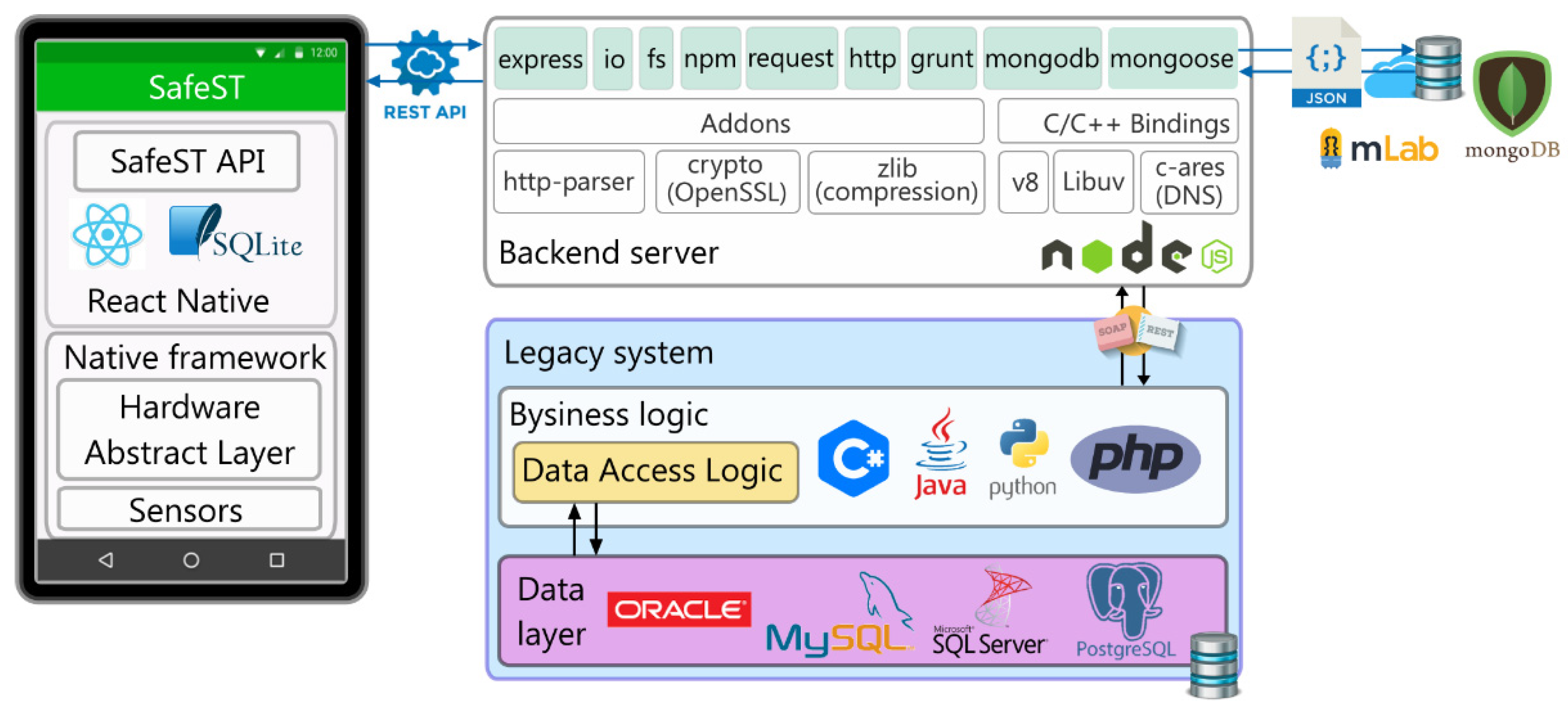
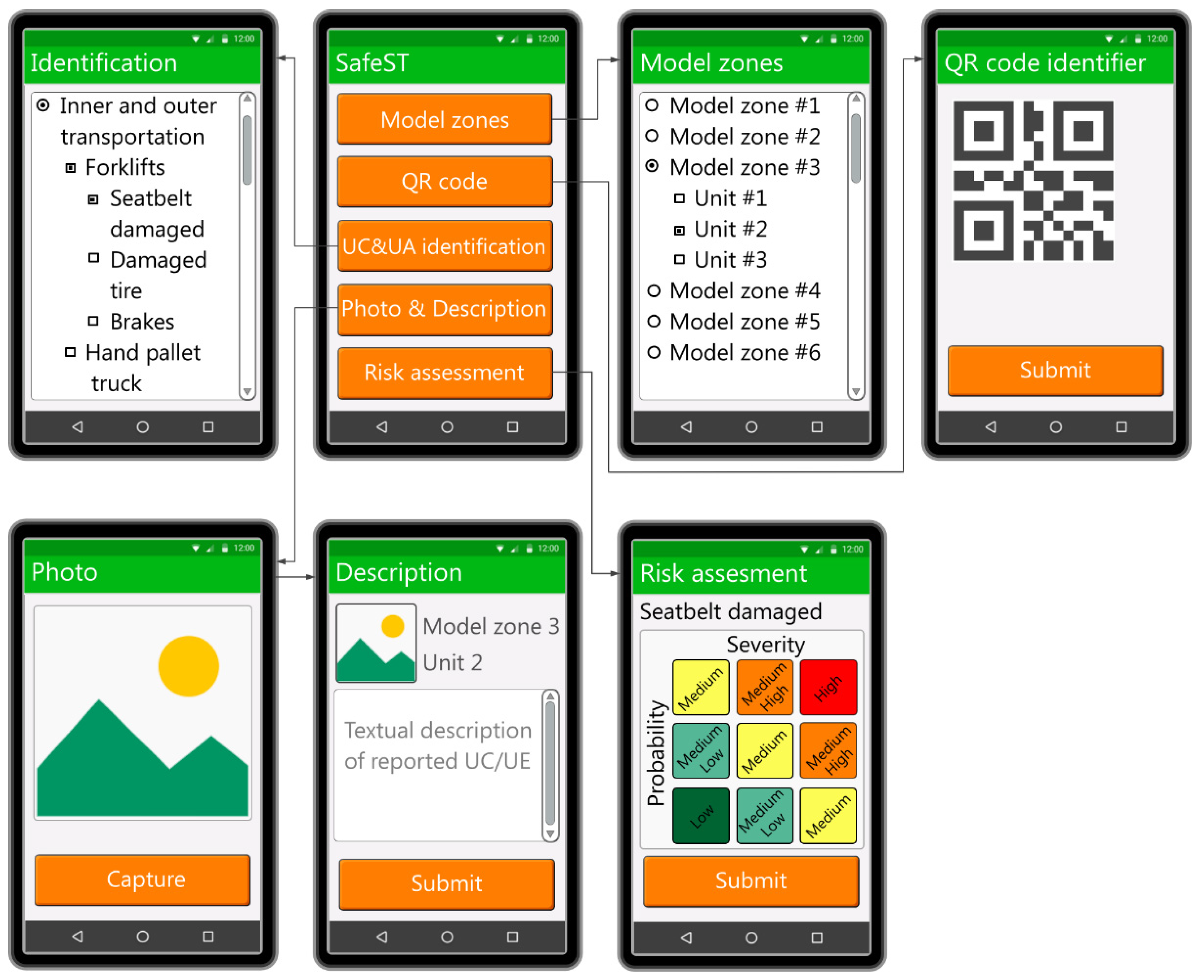
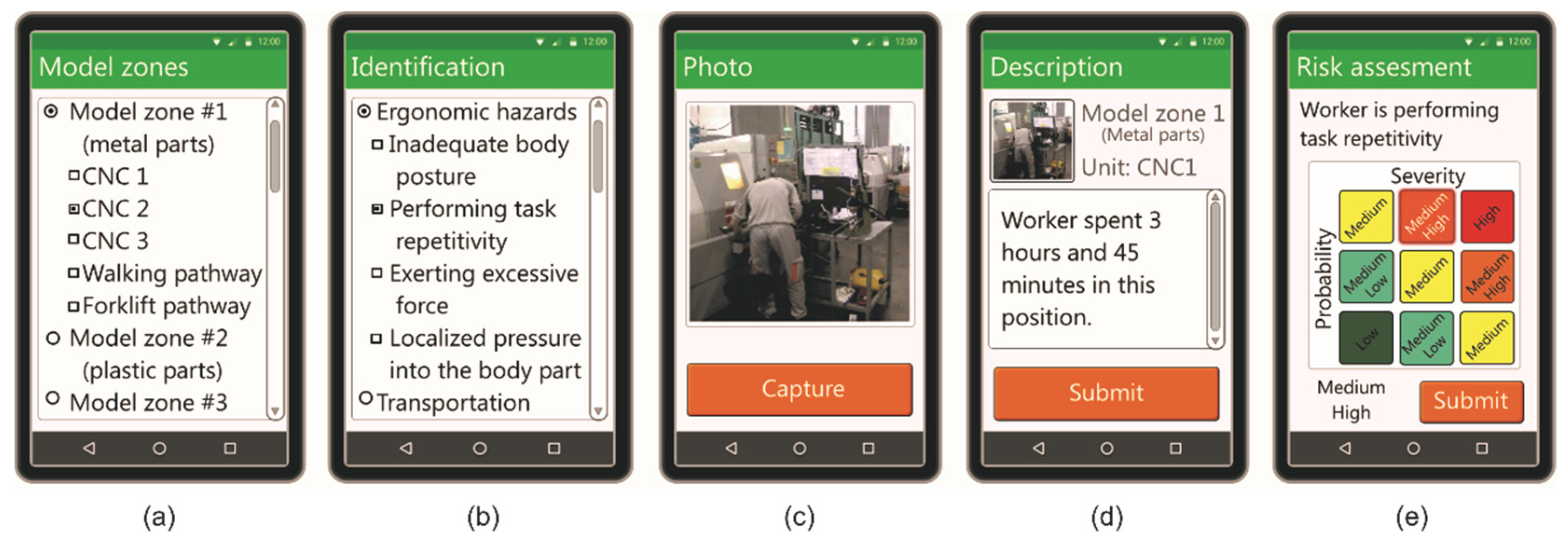
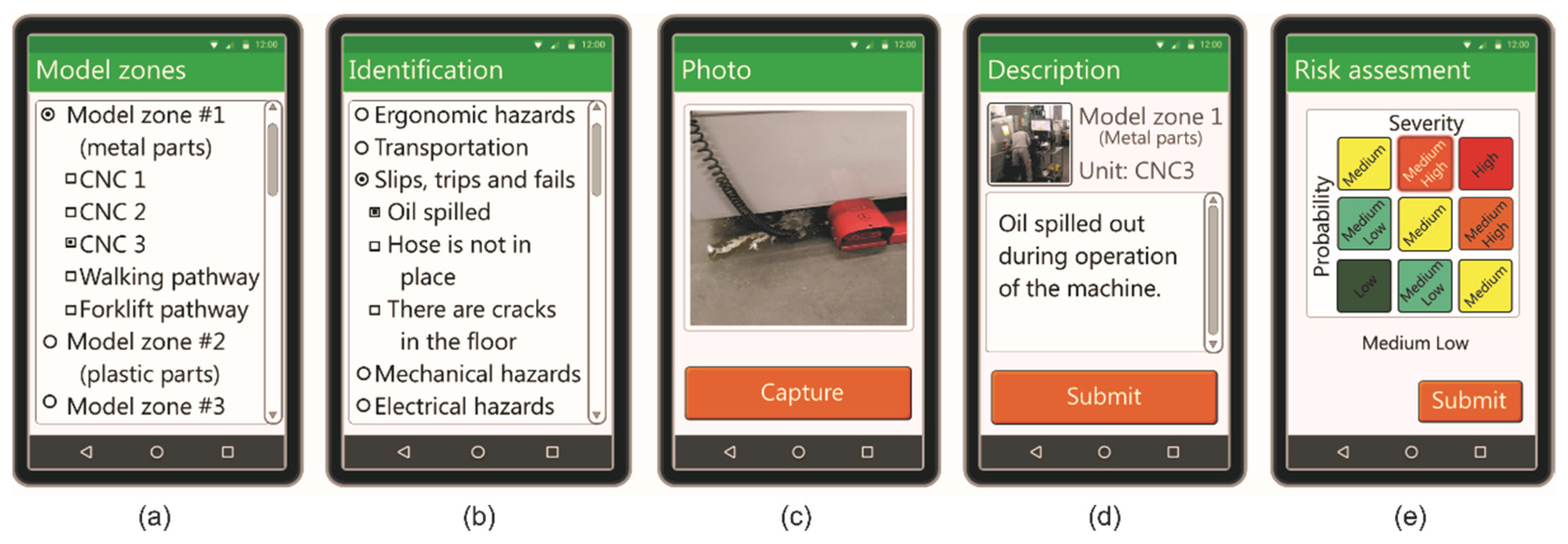
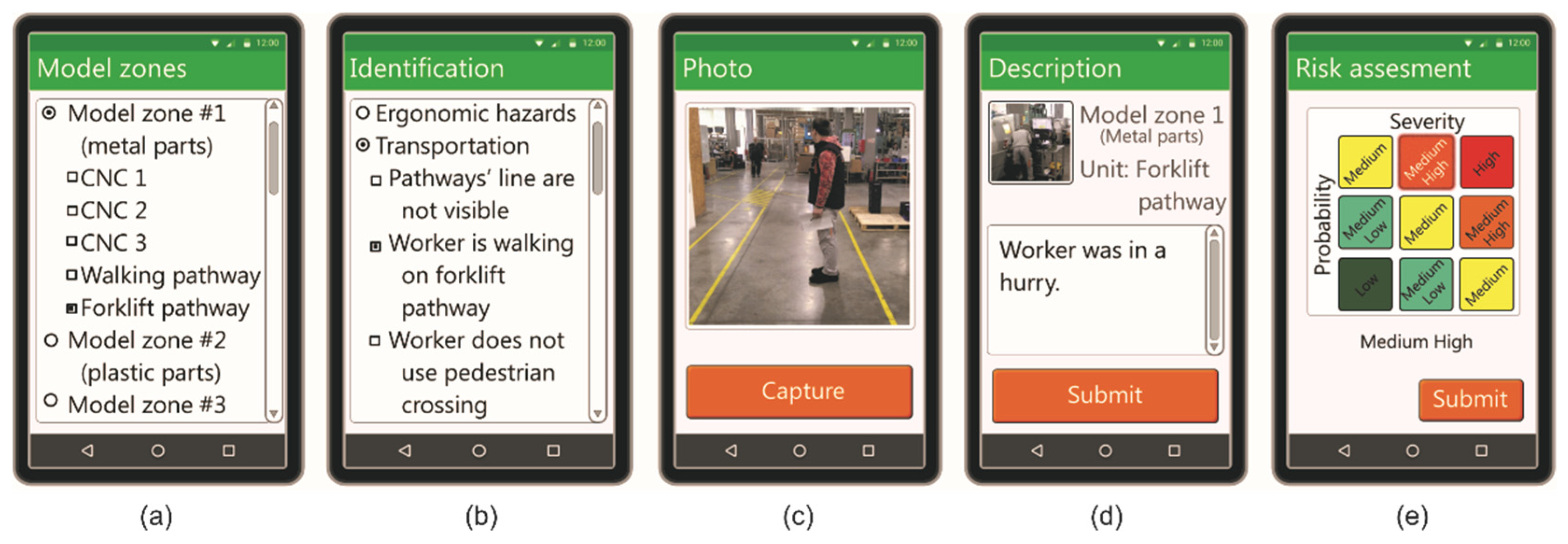
Publisher’s Note: MDPI stays neutral with regard to jurisdictional claims in published maps and institutional affiliations. |
© 2021 by the authors. Licensee MDPI, Basel, Switzerland. This article is an open access article distributed under the terms and conditions of the Creative Commons Attribution (CC BY) license (https://creativecommons.org/licenses/by/4.0/).
Share and Cite
Vukićević, A.M.; Mačužić, I.; Djapan, M.; Milićević, V.; Shamina, L. Digital Training and Advanced Learning in Occupational Safety and Health Based on Modern and Affordable Technologies. Sustainability 2021, 13, 13641. https://doi.org/10.3390/su132413641
Vukićević AM, Mačužić I, Djapan M, Milićević V, Shamina L. Digital Training and Advanced Learning in Occupational Safety and Health Based on Modern and Affordable Technologies. Sustainability. 2021; 13(24):13641. https://doi.org/10.3390/su132413641
Chicago/Turabian StyleVukićević, Arso M., Ivan Mačužić, Marko Djapan, Vladimir Milićević, and Luiza Shamina. 2021. "Digital Training and Advanced Learning in Occupational Safety and Health Based on Modern and Affordable Technologies" Sustainability 13, no. 24: 13641. https://doi.org/10.3390/su132413641
APA StyleVukićević, A. M., Mačužić, I., Djapan, M., Milićević, V., & Shamina, L. (2021). Digital Training and Advanced Learning in Occupational Safety and Health Based on Modern and Affordable Technologies. Sustainability, 13(24), 13641. https://doi.org/10.3390/su132413641





